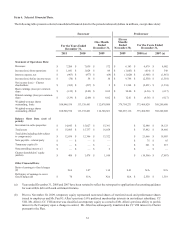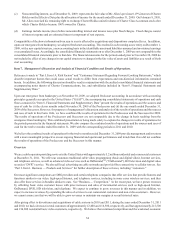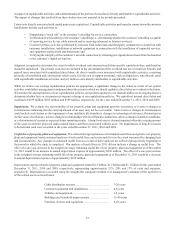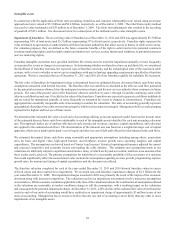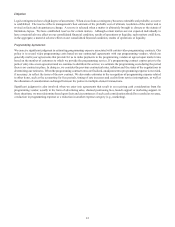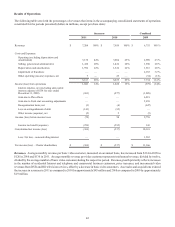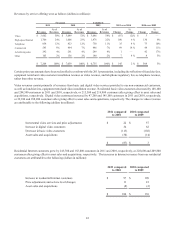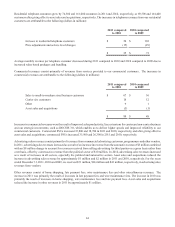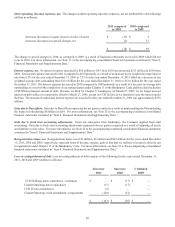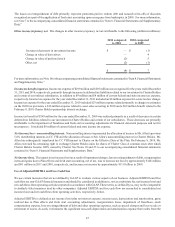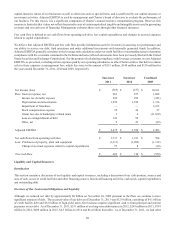Charter 2011 Annual Report Download - page 51
Download and view the complete annual report
Please find page 51 of the 2011 Charter annual report below. You can navigate through the pages in the report by either clicking on the pages listed below, or by using the keyword search tool below to find specific information within the annual report.39
Impairment and amortization of customer relationships. The net carrying value of customer relationships as of December 31,
2011 and 2010 was approximately $1.7 billion (representing 11% of total assets) and $2.0 billion (representing 13% of total assets),
respectively. Customer relationships, for valuation purposes, represent the value of the business relationship with existing customers
(less the anticipated customer churn), and are calculated by projecting the discrete future after-tax cash flows from these customers,
including the right to deploy and market additional services to these customers. The present value of these after-tax cash flows
yields the fair value of the customer relationships. The use of different valuation assumptions or definitions of franchises or
customer relationships, such as our inclusion of the value of selling additional services to our current customers within customer
relationships versus franchises, could significantly impact our valuations and any resulting impairment.
We evaluate the recoverability of customer relationships upon the occurrence of events or changes in circumstances indicating
that the carrying amount of an asset may not be recoverable. Customer relationships are deemed impaired when the carrying value
exceeds the projected undiscounted future cash flows associated with the customer relationships. No impairment of customer
relationships was recorded in the years ended December 31, 2011, 2010 or 2009.
Customer relationships are amortized on an accelerated method over useful lives of 11-15 years based on the period over which
current customers are expected to generate cash flows. Amortization expense related to customer relationships for the years ended
December 31, 2011, 2010 and 2009 was approximately $306 million, $331 million and $29 million, respectively.
Impairment of goodwill. The net carrying value of goodwill as of December 31, 2011 and 2010 was approximately $954 million
(representing 6% of total assets) and $951 million (representing 6% of total assets), respectively. Goodwill is tested for impairment
as of November 30 of each year, or more frequently as warranted by events or changes in circumstances. The first step involves
a comparison of the estimated fair value of each of our reporting units to its carrying amount. If the estimated fair value of a
reporting unit exceeds its carrying amount, goodwill of the reporting unit is not considered impaired and the second step of the
goodwill impairment is not necessary. If the carrying amount of a reporting unit exceeds its estimated fair value, then the second
step of the goodwill impairment test must be performed, and a comparison of the implied fair value of the reporting unit’s goodwill
is compared to its carrying amount to determine the amount of impairment, if any. Reporting units are consistent with the units of
accounting used for franchise impairment testing. Likewise the fair values of the reporting units are determined using a consistent
income approach model as that used for franchise impairment testing. Our 2011, 2010 and 2009 impairment analyses did not result
in any goodwill impairment charges. At December 31, 2011 a 20% decline in the fair values of each of our reporting units would
not result in an impairment charge.
Impairment of trademarks. The net carrying value of trademarks as of December 31, 2011 and 2010 was approximately $158
million (representing 1% of total assets). Trademarks are tested annually for impairment, or more frequently as warranted by events
or changes in circumstances. The fair value of trademarks is determined using the relief-from-royalty method which applies a fair
royalty rate to estimated revenue. Royalty rates are estimated based on a review of market royalty rates in the communications
and entertainment industries. As we expect to continue to use each trade name indefinitely, trademarks have been assigned an
indefinite life and are tested annually for impairment. The valuation in 2011 showed trademark values in excess of book value,
and thus resulted in no impairment.
Income taxes
All of Charter’s operations are held through Charter Holdco and its direct and indirect subsidiaries. Charter Holdco and the majority
of its subsidiaries are generally limited liability companies that are not subject to income tax. However, certain of these limited
liability companies are subject to state income tax. In addition, the indirect subsidiaries that are corporations are subject to federal
and state income tax. All of the remaining taxable income, gains, losses, deductions and credits of Charter Holdco pass through
to Charter.
As of December 31, 2011, Charter and its indirect corporate subsidiaries had approximately $7.4 billion of federal tax net operating
and capital loss carryforwards, resulting in a gross deferred tax asset of approximately $2.6 billion, expiring in the years 2014
through 2031. These losses arose from the operations of Charter Holdco and its subsidiaries. In addition, as of December 31, 2011,
Charter and its indirect corporate subsidiaries had state tax net operating and capital loss carryforwards, resulting in a gross deferred
tax asset (net of federal tax benefit) of approximately $252 million, generally expiring in years 2012 through 2031. Due to
uncertainties in projected future taxable income, valuation allowances have been established against the gross deferred tax assets
for book accounting purposes, except for future taxable income that will result from the reversal of existing temporary differences
for which deferred tax liabilities are recognized. Such tax loss carryforwards can accumulate and be used to offset Charter’s future
taxable income.






